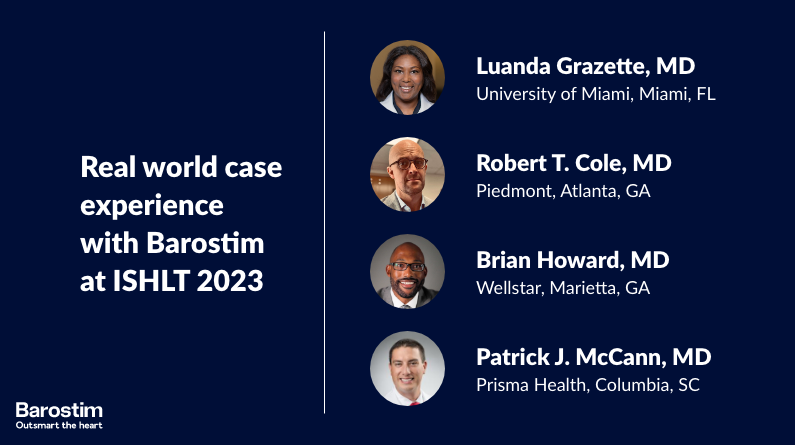- Healthcare Professionals
- Clinical Results
- Reimbursement
- Resources
- About Us
- Investors
- Overview
- News & Events
- News Releases
- Events
- Information
- Stock Quote and Chart
- Analyst Coverage
- Corporate Governance
- Documents and Charters
- Management Team
- Board of Directors
- Committee Composition
- Financial Information
- SEC Filings
- Annual Reports
- Quarterly Results
- IR Resources
- FAQs
- Email Alerts
- Contact IR

Real World Case Experience With Barostim At ISHLT 2023
At International Society for Heart and Lung Transplantation (ISHLT) 2023 in Denver on May 19, 2023, Dr. Luanda Grazette, Dr. Robert Cole, Dr. Brian Howard, and Dr. Patrick McCann had an engaging discussion about the unmet needs with guideline-directed medical therapy, and reviewed the mechanism of action, key insights of the BeAT-HF study, and patient selection for the use of Barostim in patients with HFrEF.
Watch the discussion here:
The HCPs involved in this symposium have received compensation from CVRx for their participation.
Stay up-to-date on the latest news, insights and best practices on Barostim Baroreflex Activation Therapy.
Important Safety Information
CAUTION: Federal law restricts this device to sale by or on the order of a physician. See Instructions for Use 900133-001 for a complete instruction for use and a description of indications, contraindications, warnings, precautions and adverse events.
Barostim™ Brief Summary for Physicians
The Barostim System is indicated for the improvement of symptoms of heart failure—quality of life, six-minute hall walk and functional status—for patients who remain symptomatic despite treatment with guideline-directed medical therapy, are NYHA Class III or Class II (who had a recent history of Class III), have a left ventricular ejection fraction ≤ 35%, a NT-proBNP < 1600 pg/ml and excluding patients indicated for Cardiac Resynchronization Therapy (CRT) according to AHA/ACC/ESC guidelines.
Patients are contraindicated if they have been assessed to have bilateral carotid bifurcations located above the level of the mandible, baroreflex failure or autonomic neuropathy, uncontrolled symptomatic cardiac bradyarrhythmias, carotid atherosclerosis that is determined by ultrasound or angiographic evaluation greater than 50%, ulcerative plaques in the carotid artery as determined by ultrasound or angiographic evaluation, known allergy to silicone or titanium.
Warnings include: only trained physicians may use this system, prescribing physicians should be experienced in the diagnosis and treatment of heart failure and should be familiar with the use of this system, monitor blood pressure and heart rate during Carotid Sinus Lead placement and when adjusting stimulation parameters intra-operatively, post-implantation, program the system to avoid the following: heart rate falls below 50 beats per minute (BPM), or systolic pressure falls below 90 mmHg, or diastolic blood pressure falls below 50 mmHg, or problematic adjacent tissue stimulation is noted, or undesirable interaction indicated by monitoring of any other implanted electrical device (see “Device Interaction Testing” in Section 10), or any other potentially hazardous patient responses are observed. Improper system implantation could result in serious injury or death. Do not use diathermy therapy including shortwave, microwave, or therapeutic ultrasound diathermy on patients implanted with the system. Patients should be counseled to stay at least 15 cm (6 inches) away from devices with strong electrical or magnetic fields such as strong magnets, loudspeaker magnets, Electronic Article Surveillance (EAS) system tag deactivators, arc welders, induction furnaces, and other similar electrical or electromechanical devices. This would include not placing items such as earphones in close proximity to the implanted pulse generator. The IPG may affect the operation of other implanted devices such as cardiac defibrillators, pacemakers, or neurological stimulation systems. For patients who currently have an implanted electrical medical device, physicians must verify compatibility with the implanted device during implantation of the system. Contralateral implant of the Barostim NEO IPG may help to reduce potential interactions. Interactions are more likely in devices that contain a sensing function, such as an implantable cardiac defibrillator or pacemaker. If an interaction is observed, the Barostim NEO IPG should be programmed to reduced therapy output settings in order to eliminate the interaction. If necessary, change settings in the other implant only if the changes are not expected to negatively impact its ability to perform its prescribed therapy. During the implant procedure, if device interactions cannot be eliminated the Barostim NEO System should not be implanted.
Precautions include: the system should be implanted and programmed carefully to avoid stimulation of tissues near the electrode or in the area of the IPG pocket. Such extraneous stimulation could involve the following: the regional nerves, causing laryngeal irritation, difficulty swallowing, or dyspnea, the cervical musculature, causing intermittent contraction, skeletal muscles, causing intermittent contraction around the IPG pocket. Proper sterile technique during implantation should be practiced and aggressive pre-operative antibiotics are recommended. Infections related to any implanted device are difficult to treat and may necessitate device explanation.
It is anticipated that subjects will be exposed to operative and post-operative risks similar to related surgical procedures involving the neck and/or a pacemaker implant. These risks and potential risks of chronic device based baroreflex activation may include, but are not limited to: stroke, transient ischemic attack (TIA), systemic embolization, surgical or anesthetic complications, infection, wound complications, arterial damage, pain, nerve damage/stimulation, hypotension, hypertensive crisis, respiratory, exacerbation of heart failure, cardiac arrhythmias, tissue erosion/IPG migration, injury to baroreceptors, fibrosis, allergic reaction, general injury to user or patient, need for reoperation, secondary operative procedure, and death. Patients implanted with the system may receive Magnetic Resonance Imaging (MRI) only when all MR Conditional safety parameters are met as listed in the instructions for use.
For a list of all potential benefits and risks go to www.cvrx.com/benefit-risk-analysis/